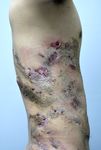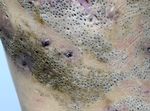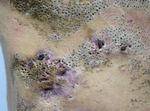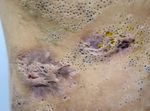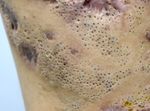Extensive Nevus Comedonicus with Inflammatory Nodules and Cysts Controlled with Adalimumab
←
→
Page content transcription
If your browser does not render page correctly, please read the page content below
Adalimumab for Extensive Nevus Comedonicus
pISSN 1013-9087ㆍeISSN 2005-3894
Ann Dermatol Vol. 33, No. 4, 2021 https://doi.org/10.5021/ad.2021.33.4.361
CASE REPORT
Extensive Nevus Comedonicus with Inflammatory
Nodules and Cysts Controlled with Adalimumab
Eun Hye Lee, Seon Hwa Lee, Chihyeon Sohng, Jun Young Kim, Kyung Duck Park, Seok-Jong Lee,
Weon Ju Lee
Department of Dermatology, Kyungpook National University Hospital, School of Medicine, Kyungpook National University, Daegu, Korea
Nevus comedonicus is a very rare skin disorder charac- INTRODUCTION
terized by the presence of comedo-like dilated pores with
keratinous plugs, rarely resulting in painful recurrent in- Nevus comedonicus is a very rare skin disorder first de-
flammatory nodules or cysts. It presents as localized or ex- scribed by Kofmann in 1895. It appears at birth or during
tensive form. It displays unilaterally or bilaterally segmental childhood and is characterized by the presence of come-
distribution. Histopathologically, it is characterized by kera- do-like dilated pores with keratinous plugs, leading to the
tin-filled epidermal invagination with bulbous proliferation development of painful recurrent inflammatory nodules or
of keratinocytes. The condition may be caused by fibroblast cysts. It presents as localized or extensive form nevus
growth factor receptor 2 mutation. Although it may be con- showing unilaterally or bilaterally segmental distribution.
trolled by a variety of therapeutic modalities, it is difficult to Histopathologically, nevus comedonicus is characterized
achieve complete resolution. We report a case of extensive by keratin-filled epidermal invagination with atrophic se-
nevus comedonicus with inflammatory nodules and cysts baceous glands or follicles. It may be caused by fibroblast
controlled with adalimumab. (Ann Dermatol 33(4) 361∼364, growth factor receptor 2 mutation1. A focal clonal defect
2021) in the growth regulation of the infundibular keratinocytes
may result in increased expression of proliferating cell nu-
-Keywords- clear antigen (PCNA), intercellular adhesion molecule 1
Adalimumab, Extensive nevus comedonicus (ICAM-1), human leukocyte antigen-DR (HLA-DR), and
2
CD68 . In the epidermal nevus syndrome, nevus come-
donicus and other epidermal nevi can be associated with
anomalies of the central nervous system, skeletal system,
and eye. Squamous cell carcinoma and basal cell carcino-
mas can occur in patients with epidermal nevus syndrome.
Inflammatory nodules and cysts in nevus comedonicus
may be controlled by topical application of retinoids, ta-
Received September 23, 2019, Revised February 10, 2020, Accepted for crolimus and calcipotriene, and by intralesional cortico-
publication February 25, 2020
steroid injection. In addition, surgical interventions, such
Corresponding author: Weon Ju Lee, Department of Dermatology,
Kyungpook National University Hospital, 130 Dongdeok-ro, Jung-gu,
as extraction, excision, dermabrasion and laser resurfac-
Daegu 41944, Korea. Tel: 82-53-420-5838, Fax: 82-53-426-0770, E-mail: ing, may yield good cosmetic results3. However, other
weonju@knu.ac.kr therapeutic modalities may be needed to treat recalcitrant
ORCID: https://orcid.org/0000-0001-5708-1305
nevus comedonicus.
This is an Open Access article distributed under the terms of the Creative
Commons Attribution Non-Commercial License (http://creativecommons.
org/licenses/by-nc/4.0) which permits unrestricted non-commercial use, CASE REPORT
distribution, and reproduction in any medium, provided the original work
is properly cited.
A 22-year old male presented with unilateral extensive
Copyright © The Korean Dermatological Association and The Korean
Society for Investigative Dermatology comedones on the right side of the chest, abdomen, back,
Vol. 33, No. 4, 2021 361EH Lee, et al
and pelvis since birth (Fig. 1A). Nodules, cysts, sinus tracts licular infundibulum with a keratin plug (Fig. 2A). In addi-
and a lot of scarring developed in the extensive come- tion, projecting bulbous proliferation of the infundibular
dones during post-adolescence (Fig. 1B, C). Medical treat- keratinocytes and perifollicular inflammatory infiltrate
ment was not effective. He did not have any systemic ab- were seen (Fig. 2B). Immunohistochemical staining showed
normalities despite the extensive cutaneous involvement. an increase in the expression of PCNA in the projecting
His past history and family history were unremarkable. bulbous proliferation of the infundibular keratinocytes and
The results of laboratory testing, including complete blood CD68 in the cells of the dermis predominantly near the
count, urinalysis, liver function tests and renal function projecting bulbous proliferation (Fig. 3). However, the ex-
tests, were within normal limits. Histopathologic examina- pression of HLA-DR and ICAM-1 in the proliferating in-
tion showed a multiplicity of the invagination of the fol- fundibular keratinocytes was not increased. The patient
Fig. 1. Clinical appearance of exten-
sive nevus comedonicus. (A∼C)
Before treatment with adalimumab,
the patient presented with extensive
comedones, nodules, cysts, sinus
tracts and a lot of scarring on the
right side of the chest, abdomen,
and back. (D, E) The patient’s lesions
got better 4 months after treatment
with adalimumab.
Fig. 2. Histopathological findings
of extensive nevus comedonicus.
(A) A multiplicity of the invagination
of the follicular infundibulum with
a keratin plug is shown (H&E,
scanning view). (B) Projecting
bulbous proliferation of infundibular
keratinocytes and perifollicular in-
flammatory infiltrates are evident
(H&E, ×40).
Fig. 3. Immunohistochemical stai-
ning (A: ×100, B: ×100) of exten-
sive nevus comedonicus with pro-
liferating cell nuclear antigen (PCNA)
and CD68. Increased expression of
(A) PCNA in the infundibular kera-
tinocytes and (B) CD68 in the cells
of the dermis near the proliferating
infundibular keratinocytes is evident.
362 Ann DermatolAdalimumab for Extensive Nevus Comedonicus
was first treated with systemic doxycycline (100 mg twice and cysts was successfully treated with subcutaneous in-
a day for 1 month), topical adapalene, incision & drain- jection of adalimumab, which is an inhibitor of tumor ne-
age, and triamcinolone intralesional injection (10 mg/ml), crosis factor (TNF)-alpha18. TNF-alpha is one of the cyto-
followed by systemic isotretinoin (10 mg twice a day for 3 kines which are involved in hidradenitis suppurativa
months), incision & drainage, and triamcinolone intrale- pathogenesis. Inflammatory nodules and cysts in this case
sional injection (10 mg/ml). However, as we expected, can be hidradenitis suppurativa-like lesions complicating
they were not effective. Finally, he was treated with adali- nevus comedonicus. Dermatologist taking care of patients
mumab (80 mg subcutaneously biweekly for 1 month, af- with hidradenitis suppurativa-like lesions should be ac-
ter then 40 mg subcutaneously weekly for 3 months). A customed to disease severity scores, such as Hurley stag-
flare-up of inflammatory nodules in nevus comedonicus ing, modified Sartorius score, physician global assessment
was not seen during treatment with adalimumab. Come- and hidradenitis suppurativa clinical response, and patient
dones have also improved. Remarkable clinical improve- reported outcomes including visual analogue pain scale,
ment was obtained in physician global assessment and vis- dermatology life quality index, and work productivity and
ual analogue scale (VAS) score. Physician global assess- activity impairment questionnaire19. We assessed improve-
ment was changed from “very severe” to “mild”, and the ment of the patient with nevus comedonicus accompany-
pain that was difficult to fall asleep was relieved from 9 to ing hidradenitis suppurativa-like lesions using physician
1 on the VAS score (Fig. 1D, E). Written informed consent global assessment and visual analogue pain scale. Mecha-
form was obtained for publication of photographs. nical stress and hormonal changes can be a triggering or
worsening factor for hidradenitis suppurativa-like lesions
DISCUSSION in nevus comedonicus20. Only several reports have de-
scribed hidradenitis suppurativa-like lesions in nevus com-
Extensive nevus comedonicus is very rare, with only a few edonicus20. In addition, there was only one report on ada-
4,5
cases reported in Korea . Nevus comedonicus is usually limumab used for treatment of hidradenitis suppurativa-
treated conservatively, with moisturizers, topical cortico- like lesions complicating nevus comedonicus in a pre-
steroids, and keratolytics6. Retinoids have also been used7. pubertal child, and has not yet been reported in Korea18.
Topical tretinoin treatment has shown limited efficacy in Adalimumab may be a therapeutic option for patients with
nevus comedonicus8. Topical tazarotene as monotherapy extensive nevus comedonicus and severe cutaneous in-
or in combination with topical mometasone furoate or cal- flammation. We herein report a case of extensive nevus
cipotriene has yielded better results9. Oral isotretinoin comedonicus with inflammatory nodules and cysts con-
may be an option in extensive nevus comedonicus with trolled with adalimumab.
inflammatory nodules and cysts10. In addition, topical clin-
damycin 1% solution/gel, systemic tetracycline and sys- CONFLICTS OF INTEREST
temic rifampicin, which are evidence-based medical ther-
apeutic options for hidradenitis suppurativa, can be con- The authors have nothing to disclose.
sidered extensive nevus comedonicus with hidradenitis
suppurativa-like lesions11. In patients refractory to medical FUNDING SOURCE
treatment, adalimumab or second line therapy can be re-
quired11. Surgical excision can be used for the removal of None.
sinus tract, scarring and localized nevus comedonicus3.
Superficial shaving, comedo extraction and dermabrasion ORCID
are also therapeutic options for nevus comedonicus3.
Laser treatment with erbium YAG, CO2 laser or diode la- Eun Hye Lee, https://orcid.org/0000-0002-4886-5439
ser has been successful in patients with nevus come- Seon Hwa Lee, https://orcid.org/0000-0003-4178-8968
donicus12-14. Despite these various therapeutic options, Chihyeon Sohng, https://orcid.org/0000-0002-1452-7896
complete resolution may not be achieved. There are no Jun Young Kim, https://orcid.org/0000-0002-2999-1018
data available on the treatment of nevus comedonicus Kyung Duck Park, https://orcid.org/0000-0002-6067-7262
with topical adapalene and systemic or topical bexarotene. Seok-Jong Lee, https://orcid.org/0000-0002-6131-632X
Other drugs of interest for treating nevus comedonicus are Weon Ju Lee, https://orcid.org/0000-0001-5708-1305
fibroblast growth factor receptor inhibitors, interleukin-1α
inhibitors, and γ-secretase-targeting agents15-17. Our patient’s
extensive nevus comedonicus with inflammatory nodules
Vol. 33, No. 4, 2021 363EH Lee, et al
REFERENCES for hidradenitis suppurativa. Rev Endocr Metab Disord
2016;17:343-351.
1. Bolognia JL, Jorizzo JL, Rapini RP, Schaffer JV. Der- 12. Caers SJ, Van der Geer S, Beverdam EG, Krekels GA,
matology. 2nd ed. London: Mosby Elsevier, 2008:109. Ostertag JU. Successful treatment of nevus comedonicus
2. Bongiorno MR, Pistone G, Aricò M. Naevus comedonicus with the use of the erbium Yag laser. J Eur Acad Dermatol
immunohistochemical features in two cases. Acta Derm Venereol 2008;22:375-377.
Venereol 2003;83:300-301. 13. Sardana K, Garg VK. Successful treatment of nevus
3. Manikavachakan N, Siddaraju MN, Rajendran SC, Venka- comedonicus with ultrapulse CO2 laser. Indian J Dermatol
taraman A. Extensive nevus comedonicus, complicated with Venereol Leprol 2009;75:534-535.
recurrent abscesses, successfully treated with surgical 14. Moody MN, Landau JM, Goldberg LH, Friedman PM.
resurfacing. J Cutan Aesthet Surg 2018;11:33-37. 1,450-nm diode laser in combination with the 1550-nm
4. Jung HJ, Cha HW, Lim HJ, Lee SJ, Kim DW, Lee WJ. Two fractionated erbium-doped fiber laser for the treatment of
concurrent facial epidermal nevi without systemic abnor- steatocystoma multiplex: a case report. Dermatol Surg
malities: nevus sebaceus and nevus comedonicus. Ann 2012;38(7 Pt 1):1104-1106.
Dermatol 2014;26:501-504. 15. Liang G, Liu Z, Wu J, Cai Y, Li X. Anticancer molecules
5. Ham SP, Park HJ. Case study of extensive nevus come- targeting fibroblast growth factor receptors. Trends Pharmacol
donicus in a middle-aged woman. Korean J Dermatol 2019; Sci 2012;33:531-541.
57:230-232. 16. Dinarello CA, Simon A, van der Meer JW. Treating
6. Milton GP, DiGiovanna JJ, Peck GL. Treatment of nevus inflammation by blocking interleukin-1 in a broad spectrum
comedonicus with ammonium lactate lotion. J Am Acad of diseases. Nat Rev Drug Discov 2012;11:633-652.
Dermatol 1989;20(2 Pt 2):324-328. 17. Ohta K, Mizuno A, Ueda M, Li S, Suzuki Y, Hida Y, et al.
7. Decherd JW, Mills O, Leyden JJ. Naevus comedonicus-- Autophagy impairment stimulates PS1 expression and
treatment with retinoic acid. Br J Dermatol 1972;86:528- gamma-secretase activity. Autophagy 2010;6:345-352.
529. 18. Sahu P, Aggarwal P, Dayal S, Kumar Jain V. Biologic
8. Manola I, Ljubojević S, Lipozencić J, Pustisek N. Nevus therapy: a boon for hidradenitis suppurativa-like lesions
comedonicus--case report and review of therapeutical complicating naevus comedonicus in a prepubertal child.
approach. Acta Dermatovenerol Croat 2003;11:221-224. Clin Exp Dermatol 2019;44:322-324.
9. Deliduka SB, Kwong PC. Treatment of nevus comedonicus 19. Kimball AB, Jemec GB, Yang M, Kageleiry A, Signorovitch
with topical tazarotene and calcipotriene. J Drugs Dermatol JE, Okun MM, et al. Assessing the validity, responsiveness
2004;3:674-676. and meaningfulness of the Hidradenitis Suppurativa Clinical
10. Peck GL, Yoder FW. Treatment of lamellar ichthyosis and Response (HiSCR) as the clinical endpoint for hidradenitis
other keratinising dermatoses with an oral synthetic suppurativa treatment. Br J Dermatol 2014;171:1434-1442.
retinoid. Lancet 1976;2:1172-1174. 20. Ravaioli GM, Neri I, Zannetti G, Patrizi A. Congenital nevus
11. Gulliver W, Zouboulis CC, Prens E, Jemec GB, Tzellos T. comedonicus complicated by a hidradenitis suppurativa-
Evidence-based approach to the treatment of hidradenitis like lesion: report of a childhood case. Pediatr Dermatol
suppurativa/acne inversa, based on the European guidelines 2018;35:e298-e299.
364 Ann DermatolYou can also read




